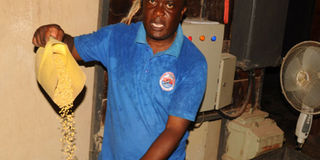You can mill soya products to make money, be healthy

Mr Deogratius Ssemwogerere puts soya grains in the milling machine at his small scale factory in Kasangati, Wakiso District. Soya can be used in the making of other products that can bring you money. PHOTO BY COLLEB MUGUME
What you need to know:
Soya processing is one project that can make one prosper because the crop can be used in the making of many products for sale. Dorothy Nakaweesi writes that with soya you can make milk, flour, soya coffee and much more
Besides soya being a source of edible oil rich in proteins, it can also be used in the making of other products that can bring you money.
Whole soya is used to make innumerable products, including soya milk, soya flour, soya coffee and so on.
These products have gained consumer acceptance in Uganda, and in many other parts of the world and a steady growth of market is expected.
According to Mr Charles Nsubuga, the managing director - Sesaco Ltd, a soya milling company, investing in soya milling comes with a lot of benefits because it’s more than one getting just the flour.
“If you are looking out to prosper you start small and then grow big. I can assure you the benefits of investing in this business are vast,” Mr Nsubuga said.
He said the beauty about this investment is that one can start from the home kitchen; adding that there is a big market.
Investment
Experts in this business say, it can be done at different levels from a small backyard of one’s home to a well-established facility.
Mr Nsubuga says with only Shs200, 000, one can start processing soya using a kitchen blender to make soya milk.
With this investment one can process more than 30 litres of soya milk per day.
With a litre costing Shs4,000, one can be assured of Shs120, 000 per day. This translates into Shs3.6 million a month.
For the relatively affluent investor, those who want to use more advanced technologies, it can take one to invest about Shs50 million.
But for those who want to do it on a very large scale depending on the technologies available and what one wants besides soya flour, they can start with as much as $2 million (Shs7.2 billion).
Market
The potential markets for soya flour are in the school feeding programmes and social welfare feeding programmes.
It is also demanded in confectionery industries, baking industries for nuggets and chunks manufacturing as a supplement for wheat flour.
Raw material which is soya bean is a widely grown commodity in Uganda in the districts of Pallisa, Soroti, Kumi and many others.
Mr Daniel Joloba, the chief executive officer at Big Finance, a firm that does advisory and consultancy for small and medium enterprises, says after setting up a soya processing plant it is very important to develop market strategies that will bring in customers.
He shares that one strategy is to look out for bulk buyers such as institutions who will keep you busy and in business.
“Institutional buyers such as hospitals, schools must be on the list of your clients and these are the kind of clients who will keep you in business all year around,” he advised.
Mr Joloba adds that it is very important to have a factory shop to display the products that you process. This is a good marketing strategy that attracts those who visit your plant to see the kind of work you do.
Other necessities
The other important issue when investing in this kind of business, Mr Joloba shares, is that the plant has to be placed in a location which is accessible to one’s clients, and it has to have power supply all the time.
“Package your products in well branded materials and always look out to certify the products you produce as this will enable you to access the international market,” Mr Joloba says.
Incentives
According to Mr John Musajjakawa, the Uganda Investment Authority senior investment officer, those adding value to agricultural commodities get incentives from government.
“Government is willing to finance agro-processing industries and provide technical support to them in a bid to promote industrialisation,” he said.
Soya bean is said to be the most nutritious food crop in the world.
It has been a priority crop in all those countries that are today economic giants such as the US, Japan and China; and it continues to enjoy international acceptance.




